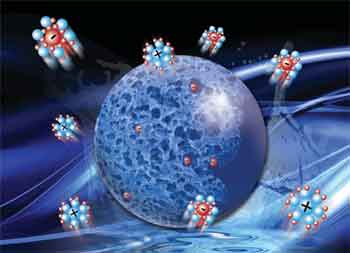
Because of their unique structure, carbon aerogels may be used for hydrogen and electrical energy storage in the future.
Carbon aerogels (CAs) are a unique class of high-surface area materials derived by sol-gel chemistry in which the liquid component of a polymer gel has been replaced with a gas.
Their high surface area and electrical conductivity, environmental compatibility and chemical inertness make them very promising materials for many energy related applications.
Recent research has shown that the structure of carbon aerogels can be manipulated for a variety of uses in the energy field from hydrogen and electrical storage to desalination and catalysis.
Laboratory research in the aerogel field was recently featured on the back cover of Energy and Environmental Science authored by Juergen Biener, Monika Biener, Michael Stadermann, Marcus Worsley, Theodore Baumann, Matthew Suss and Klint Rose.
Although the first aerogels based on silica gels were discovered in 1931, it was another 60 years until LLNL developed polymer-based carbon aerogels in the late ’80s.
Because of their unusual chemical and textural characteristics, carbon aerogels are promising materials for use as electrode materials in supercapacitors and rechargeable batteries, advanced catalyst supports, adsorbents and thermal insulation.
According to the LLNL team, the sol-gel reaction chemistry allows researchers to manipulate the structure and properties of carbon aerogels.
“Carbon aerogels are attractive materials for applications that require both high surface areas and fast mass transport,” because the structure, surface area and pore size distribution can be controlled systematically, Juergen Biener said.
For example, the hydrogen and electrical energy storage capacity of carbon aerogels depends on the presence of micropores to provide surface area, but the dynamics of loading and unloading depends on the presence of macropores to facilitate mass transport.
The storage capacity for hydrogen and electricity could be improved by manipulating the structure of the carbon aerogels, Baumann said.
The team currently develops new carbon aerogels that improve the storage capacity of electrical double-layer capacitors. In these devices charge is stored in the form of ions accumulated on the surface of the material, creating an intermediate between batteries and electrostatic capacitors. These capacitors are an ideal complement to batteries in devices with peak power demands above the base level, where they extend the life of the battery.
Carbon aerogels also have an important role in capacitive deionization (CDI), a desalination method in which ions are removed from electrolytes (seawater or brackish water flowing between electrode pairs) to create a clean water source. The first CDI system that used aerogel electrodes was developed in the 1990s at LLNL.
“Tuning the pore size distribution in hierarchically structured carbon aerogels can improve the energy efficiency of a CDI system by reducing ionic transport losses while maintain a high capacitance,” Stadermann said.
Another promising energy application for carbon aerogels is their use as electrode materials and catalyst support in proton-exchange membrane fuel cells.
“The advantage of aerogels over other more traditional supports is that its surface area, pore size and pore volume can be tailored independently of each other,” Biener said.
Juergen Biener, Baumann, Stadermann, Monika Biener, Worsley, Suss and Rose are the founding members of the Livermore Materials for Energy Initiative (LMEI), which has the goal of developing novel materials for sustainable energy applications.



